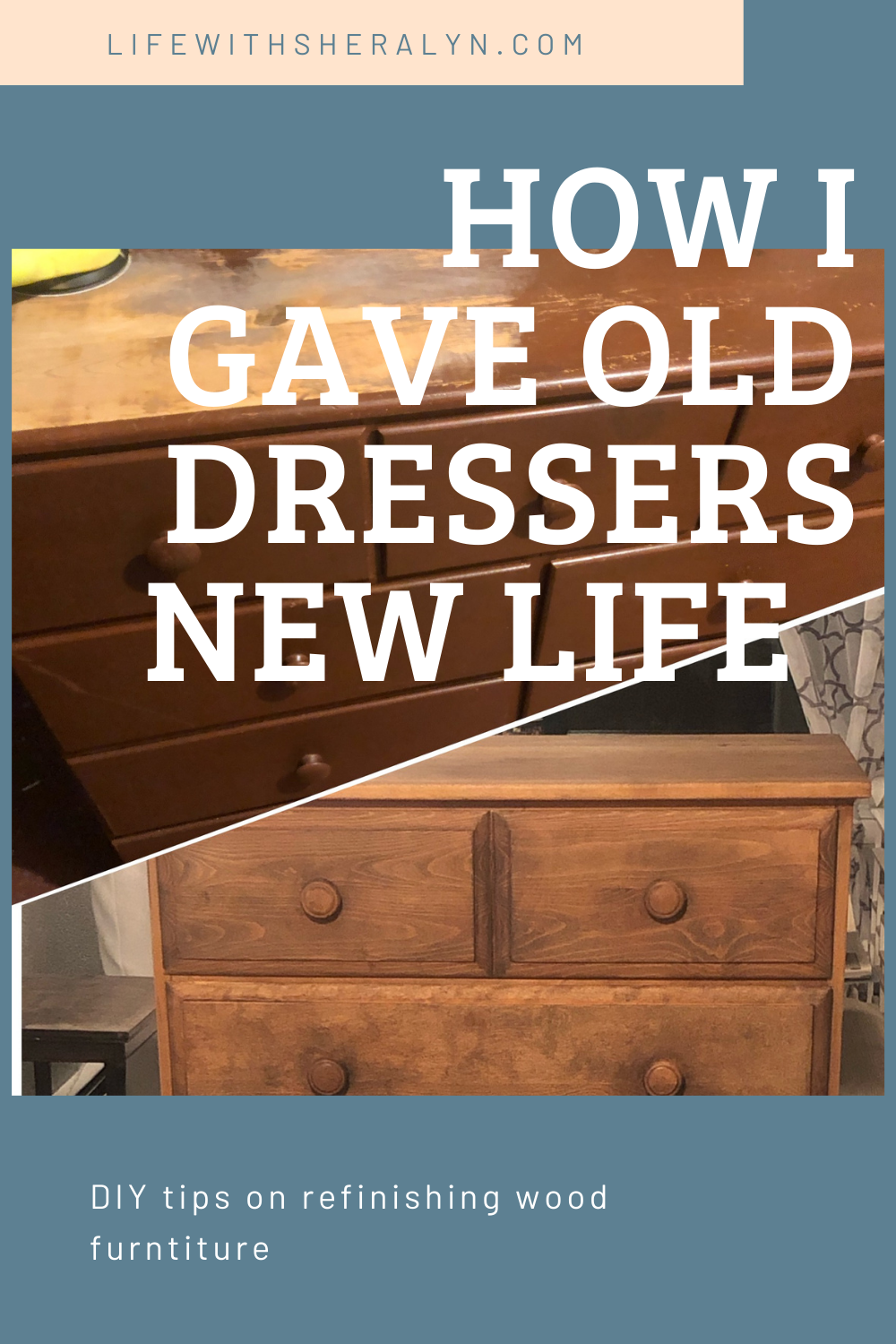As an Amazon Associate I earn from qualifying purchases.
We had a rough year as many people did. 2020, one for the history books… if nothing less. In addition to all the craziness, we lost 3 grandmas between my husband and I. Sad as it was, I got some beautiful momentos from 2 of them – dressers.
I am honestly really excited about it. I am a sentimental person, so it’s nice because now I get to see these new dressers everyday and think of them! Bonus, I REALLY needed new dressers. I have lived a life of hand-me-downs and my dressers were no exception. Don’t get me wrong, I am not too prideful for hand-me-downs, I got nice stuff! However, these dressers were my cousin’s childhood dressers and they were falling apart. Point is, I really needed new dressers and to buy new ones = very expensive.
So my grandmother’s dresser is really tall and beautiful and made of wood! Whoohoo! It was honestly really beautiful how it was, but I just wasn’t a huge fan of the finish and it didn’t necessarily fit into my bedroom.

I knew I needed 2 dressers though so I thought I would wait until I found a dresser to match and then try and match the stain best I could.
But then, again sad news – Lucas’ grandma passed, but weirdly she had a dresser that went well with the other dresser only it was painted a color I didn’t like.

But it was SUCH a blessing! I knew I could remove the paint and put the same stain on both dressers and voila two new dressers! Blessed Blessed Blessed!
So now that I had 2 dressers for my bedroom and a week off for holiday break, it was time to make them into what I was hoping they could be.
Step 1 – Remove the old finish
I decided that I was going to remove the old finishes by using an orbit sander. The one I used was from Home Depot and it was battery operated. I loved using a battery-operated one because I could move it anywhere and I didn’t need to be super close to an outlet, but then again I used the shop vacuum on the end so I kind of needed an outlet anyway.
The only thing I didn’t like was that the battery died kind of quickly, but luckily my husband had a lot of extra Ryobi batteries. I got 2 big dressers done with this orbit sander and it was pretty great – here’s the one I used.
To get started on removing the finish I started with an 80-grit sand paper like this one. I definitely recommend continuing with the 80-grit sandpaper until the finish is removed, I unfortunately ran out of 80-grit and used 60-grit on the painted dresser. It is not as recommended, it was a little too harsh on the wood even though it got the job done.

For the tall dresser, it had more of glossy finish and stain so it required less force to strip the finish. I used a 120-grit sandpaper on the entire dresser.
When you’re sanding, make sure you’re in a well-ventilated area. The saw dust gets EVERYWHERE! So make sure you’re in an area where you won’t mind saw dust getting on items nearby. You’ll also want to make sure you wear a mask because inhaling saw dust is not a fun time. I learned the hard way, but it can help to plug the sander into the shop vacuum.
Here’s a picture of each dresser stripped down to just the plain wood.


To continue preparing the wood for refinishing, I used a finer sandpaper such as 120-grit to smooth the surface and enhance the grain. It would have been REALLY perfect if I progressed to 220-grit for finishing, but I wanted to get my project done so I settled for a 120-grit finish. It worked perfectly fine, but I think I would have liked the 220 a little better, especially on the long dresser where I started with 60-grit.
Step 2. Preparing the wood
Before adding anything to the wood, I had to make sure to remove the saw dust from the dressers. To do this, I used tack cloth and a damp paper towel to make sure the dressers were clean of all saw dust.
Some people recommend finishing with one final sand on the piece while wet to bring the grain out even further, I sort of did this by sanding after it was mostly dry and this brought out the stain further. Then I used the tack cloth one more time to be extra sure there was no saw dust left.
Once the dressers were clear of any saw dust, I used a pre-stain Wood Conditioner (paid link) by Varathane before applying the stain. This is a recommended step before applying any stain, but isn’t always needed.
There are some projects that I have done where I didn’t think the wood conditioner was necessary. It didn’t seem to make much of a difference in those projects, but I didn’t want to risk ANYTHING with these dressers.
I’ll add a sub topic here of preparing my stain. I didn’t have the exact stain that I wanted so I decided to mix 2 stains together. I used Minwax Wood Stain Jacobean and Varathane Wood Stain Weathered Gray with Polyurethane. (The stain linked here was the closest thing I could find to what I used)
I mixed about 80% Weathered Gray and 20% Jacobean.
3. Applying the Stain
I wanted the dressers to have a grayed brown, for lack of a better term haha. So mixing these those two stains seemed to make the most sense and I liked how it looked.
In order to test if this was the color I wanted, I tested it on the side of the drawer in the back and on another 2×4. It’s best to find an inconspicuous spot on your project because each type of wood and even how it’s sanded can affect how the wood takes the stain.
I used an old shirt of my husbands to rub the stain onto the dressers. It was MESSY! I thought I could get by without gloves, but I definitely should have worn them. So if you have disposable gloves, I highly recommend wearing them.
This next part just takes time, I put the stain on with the shirt on and whenever their was excess stain, I wiped it off so it was a smooth finish. It is hard to mess up stain because it doesn’t act like paint, as long as it makes it to the areas on the wood project that it should be, it will stain the wood. Just make sure there isn’t excess or it will be too dark in that particular spot.
After the time consuming work on applying the stain, I didn’t feel that it needed an additional coat because I liked how it looked. You could always add a second coat a couple of hours after applying the initial stain if you’d like it darker. Keep in mind that some stains area buildable, but some don’t work as well. It’s always worth testing it if you’re worried.
I decided to not add a finisher on top of the stain because the Weathered Gray had Polyurethane in it and because it had 80% of that stain, I just didn’t think it needed additional finish. If you were making something with more traffic on it, such as a table, you would definitely want to add a more durable finish.
4. The Finished Product
Once the dressers were stained and set for about a week, I was able to put them in my bedroom. I wanted to give them extra time to dry and set so they wouldn’t affect my clothes and I learned the hard way when putting our DIY headboard together that the stain can have a smell for awhile.
The Before…


The After!

I LOVE how these dressers elevate the room! The tall dresser is so much bigger than the one I had and the long dresser has more drawers and even though it takes up less space, there’s actually room left in it for possibly more things!
My final thoughts – The two dressers took the stain slightly differently because they were different types of wood and I had to sand the long dresser more aggressively than the tall one, that may have affected how they took the stain also.
I hope this inspires you that you can do it too and have fun making things your own!


No responses yet